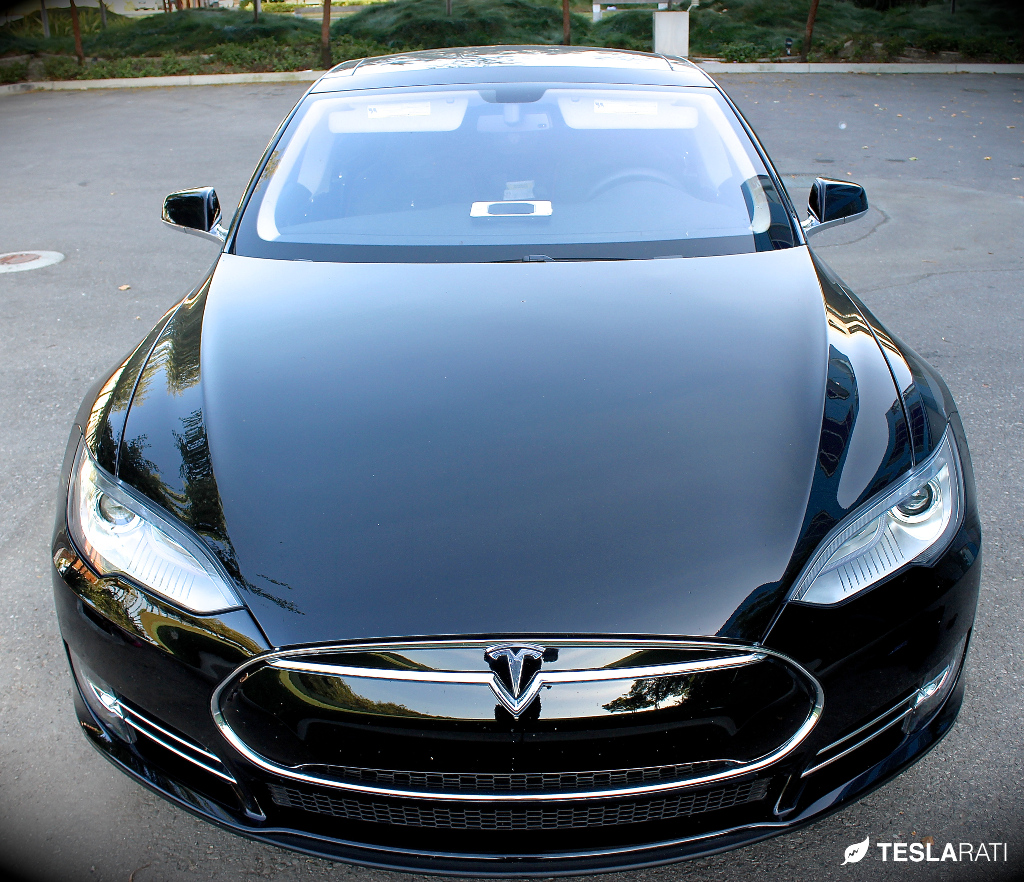

News
How to Decode Your Tesla Model S VIN
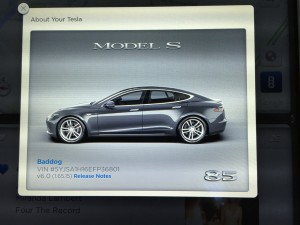 With the Model X delivery around the corner, the recent announcement of the Model 3 and the much anticipated unveiling of the “D”, we thought it would be fun decode the Model S Vehicle Identification Number (VIN) and take a wild guess on how future VINs may look like.
With the Model X delivery around the corner, the recent announcement of the Model 3 and the much anticipated unveiling of the “D”, we thought it would be fun decode the Model S Vehicle Identification Number (VIN) and take a wild guess on how future VINs may look like.
Finding your VIN
The VIN is a 17 character alphanumeric fingerprint to your vehicle often found on the lower left corner of your dashboard and against the windshield. Law requires that it be placed in a visibly prominent spot on the car and for that reason it’s not a secret code, dispelling the myth that your VIN is a confidential identifier. I’d hate to break it to you but your VIN is not a secret.
The Tesla Model S VIN can also be viewed by pressing the Tesla logo at the top of the 17″ display. The VIN is required by DMV and also when registering your vehicle with the insurance company because it provides a wealth of information about your vehicle.
Decoding the Tesla Model S VIN
Referencing Tesla’s filing with the National Highway Traffic Safety Administration (NHTSA), here’s how we can decode the Model S VIN.
The first digit in the VIN indicates the vehicle’s country of origin which can also be its assembly location. Referencing CarFax we know that 5 represents the country code for the USA. The second character, Y, is for Tesla Motors as the Manufacturer. The third character, J, represents the vehicle type. Things start to become even more detailed as we start moving into the Vehicle Descriptor Section.
The make of vehicle is the first character within the Vehicle Descriptor Section. S is for the Model S, R for the Roadster and following this pattern we should expect to see codes of X, 3, and possibly D down the road.
The next character, A, is the body type and represents a 5 door hatchback with left hand drive. Right hand drive Model S’ use the letter B. The restraint system has had a few different variations but a 1 represents Manual Type 2 USA Seat Belts while Dual Front Airbags, Front/Rear Side Airbags, Knee Airbags etc. utilize their own set of codes.
The battery type, H, is for the 85kWh battery, and S is for the 60kWh battery. The final digit indicates the number of drive units (motors). This will be 2 for the Model X. Based on this Tesla Motors NHTSA VIN filing, it’s almost certain that a dual motor Model S will soon be announced. We’ll expect to see a 2 in the VIN of the Model S “D”.
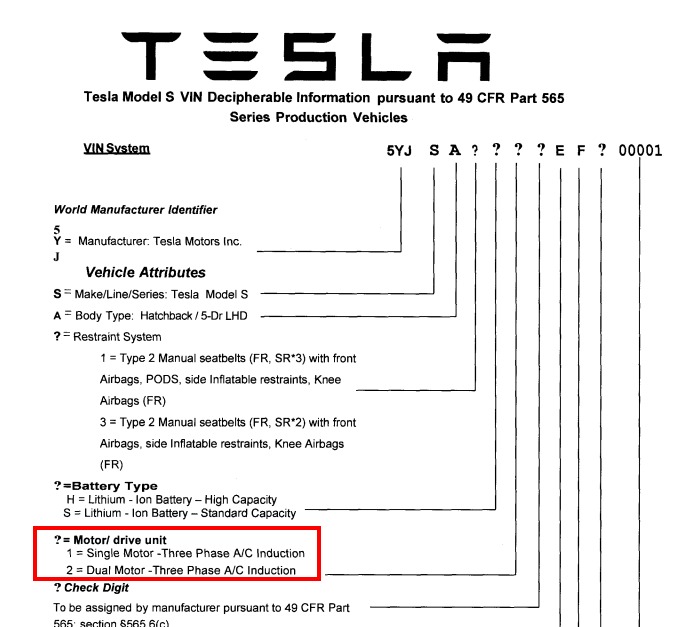
The next code labeled Check Digit is just a way for agencies to verify the VIN through a mathematical algorithm. The year is a code with E representing 2014, F for 2015 etc.
The assembly plant is F which stands for Fremont, CA and there appear to be other plant codes they’ve used in the past. As Tesla starts assembly in other countries we’ll expect to see new codes here.
The first character of the production number indicates the stage of production with a few interesting codes:
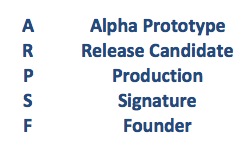 Mine is a P for production level. The final 5 digits are a unique serial number. People often abbreviate their VIN with just the production number, so P36801 in my example.
Mine is a P for production level. The final 5 digits are a unique serial number. People often abbreviate their VIN with just the production number, so P36801 in my example.
The Tesla Motors VIN is constantly evolving as the electric carmaker continues to expand their lineup and into different markets. Don’t for one second think it’s just simple letter or number because in reality each one represents exciting new changes for Tesla Motors.
What does your VIN say about your car? Let us know in the comments below.

News
Tesla is improving Giga Berlin’s free train service for employees
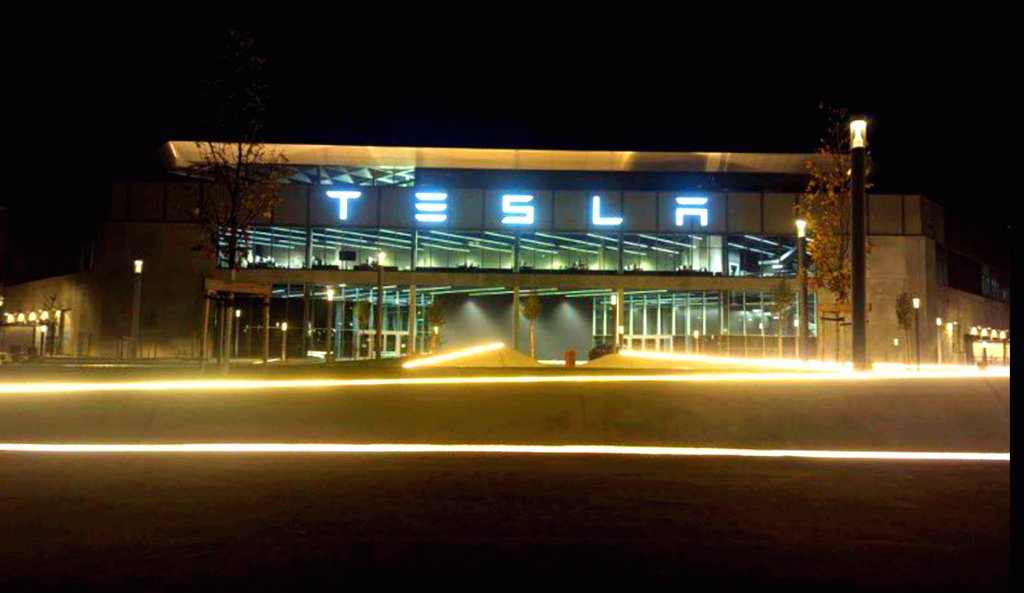
Tesla will expand its factory shuttle service in Germany beginning January 4, adding direct rail trips from Berlin Ostbahnhof to Giga Berlin-Brandenburg in Grünheide.
The upgraded link, which includes six daily services aligned with shift schedules, reduces travel time to roughly 35 minutes despite ongoing station construction. With this initiative, Tesla aims to boost the number of Gigafactory Berlin employees commuting by rail while keeping the shuttle free for all riders.
New shuttle route
As noted in a report from rbb24, the new service will run between the Berlin Ostbahnhof East Station and the Erkner Station at the Gigafactory. Tesla stated that the timetable mirrors shift changes for the facility’s employees, and similar to before, the service will be completely free. The train will offer six direct trips per day as well.
“The service includes six daily trips, which also cover our shift times,” Tesla stated. “The trains will run between Berlin Ostbahnhof (with a stop at Ostkreuz) and Erkner station to the Gigafactory.”
Even with construction continuing at Fangschleuse and Köpenick stations, the company said the route has been optimized to maintain a predictable 35-minute travel time. The upgrade follows earlier phases of Tesla’s self-funded shuttle program, which initially connected Erkner to the factory grounds before expanding to Berlin-Lichtenberg.
Tesla pushes for majority rail commuting
Tesla began production at Grünheide in March 2022, and the factory’s workforce has since grown to around 11,500 employees, with an estimated 60% commuting from Berlin. The facility produces the Model Y, Tesla’s best-selling vehicle, for both Germany and other territories.
The company has repeatedly emphasized its goal of having more than half its staff rely on public transportation rather than cars, positioning the shuttle as a key part of that initiative. In keeping with the factory’s sustainability focus, Tesla continues to allow non-employees to ride the shuttle free of charge, making it a broader mobility option for the region as the site’s output and workforce continue to scale.
News
Tesla Model 3 and Model Y dominate China’s real-world efficiency tests
The Tesla Model 3 posted 20.8 kWh/100 km while the Model Y followed closely at 21.8 kWh/100 km.
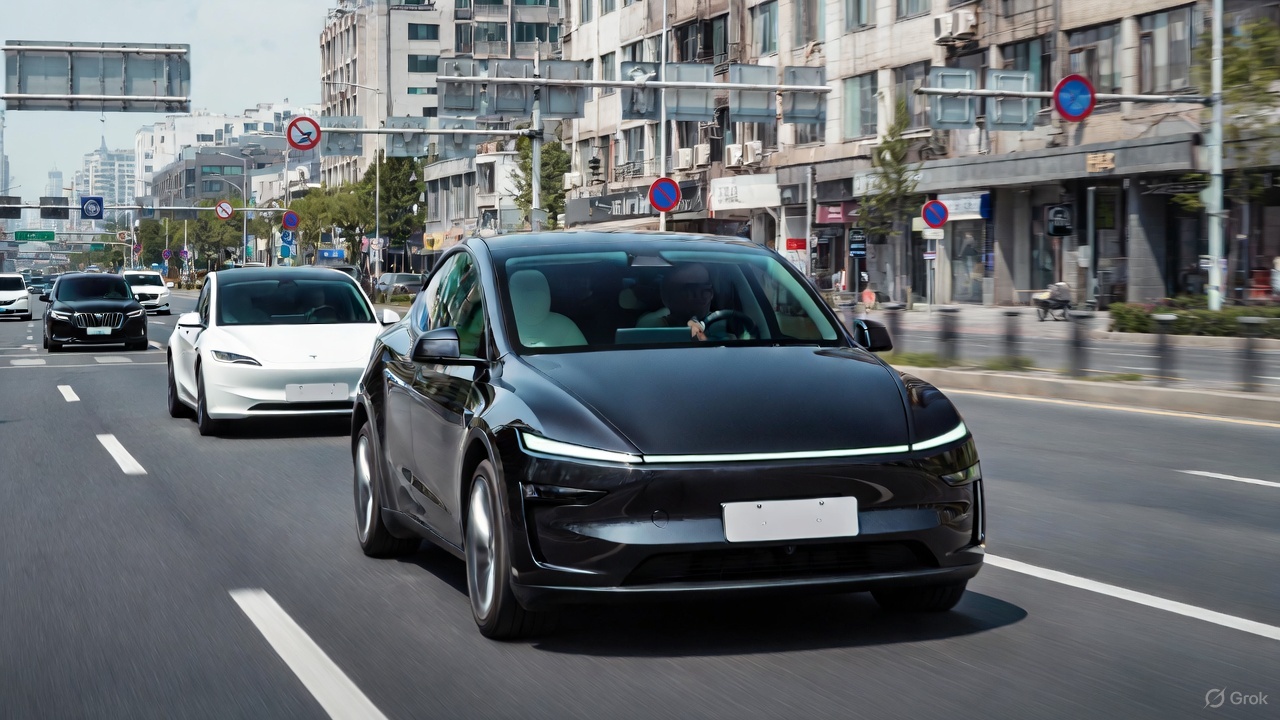
Tesla’s Model 3 and Model Y once again led the field in a new real-world energy-consumption test conducted by China’s Autohome, outperforming numerous rival electric vehicles in controlled conditions.
The results, which placed both Teslas in the top two spots, prompted Xiaomi CEO Lei Jun to acknowledge Tesla’s efficiency advantage while noting that his company’s vehicles will continue refining its own models to close the gap.
Tesla secures top efficiency results
Autohome’s evaluation placed all vehicles under identical conditions, such as a full 375-kg load, cabin temperature fixed at 24°C on automatic climate control, and a steady cruising speed of 120 km/h. In this environment, the Tesla Model 3 posted 20.8 kWh/100 km while the Model Y followed closely at 21.8 kWh/100 km, as noted in a Sina News report.
These figures positioned Tesla’s vehicles firmly at the top of the ranking and highlighted their continued leadership in long-range efficiency. The test also highlighted how drivetrain optimization, software management, and aerodynamic profiles remain key differentiators in high-speed, cold-weather scenarios where many electric cars struggle to maintain low consumption.
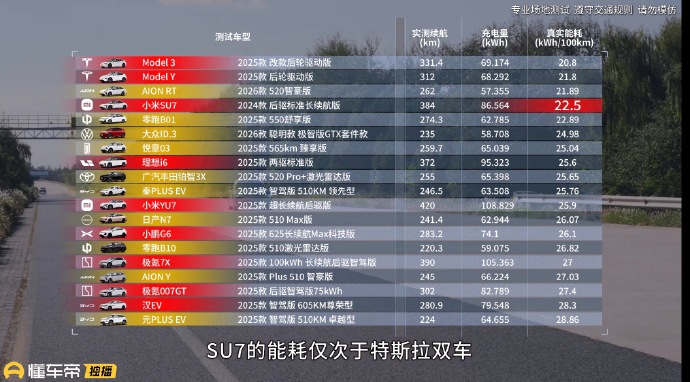
Xiaomi’s Lei Jun pledges to continue learning from Tesla
Following the results, Xiaomi CEO Lei Jun noted that the Xiaomi SU7 actually performed well overall but naturally consumed more energy due to its larger C-segment footprint and higher specification. He reiterated that factors such as size and weight contributed to the difference in real-world consumption compared to Tesla. Still, the executive noted that Xiaomi will continue to learn from the veteran EV maker.
“The Xiaomi SU7’s energy consumption performance is also very good; you can take a closer look. The fact that its test results are weaker than Tesla’s is partly due to objective reasons: the Xiaomi SU7 is a C-segment car, larger and with higher specifications, making it heavier and naturally increasing energy consumption. Of course, we will continue to learn from Tesla and further optimize its energy consumption performance!” Lei Jun wrote in a post on Weibo.
Lei Jun has repeatedly described Tesla as the global benchmark for EV efficiency, previously stating that Xiaomi may require three to five years to match its leadership. He has also been very supportive of FSD, even testing the system in the United States.
Elon Musk
Elon Musk reveals what will make Optimus’ ridiculous production targets feasible
Musk recent post suggests that Tesla has a plan to attain Optimus’ production goals.
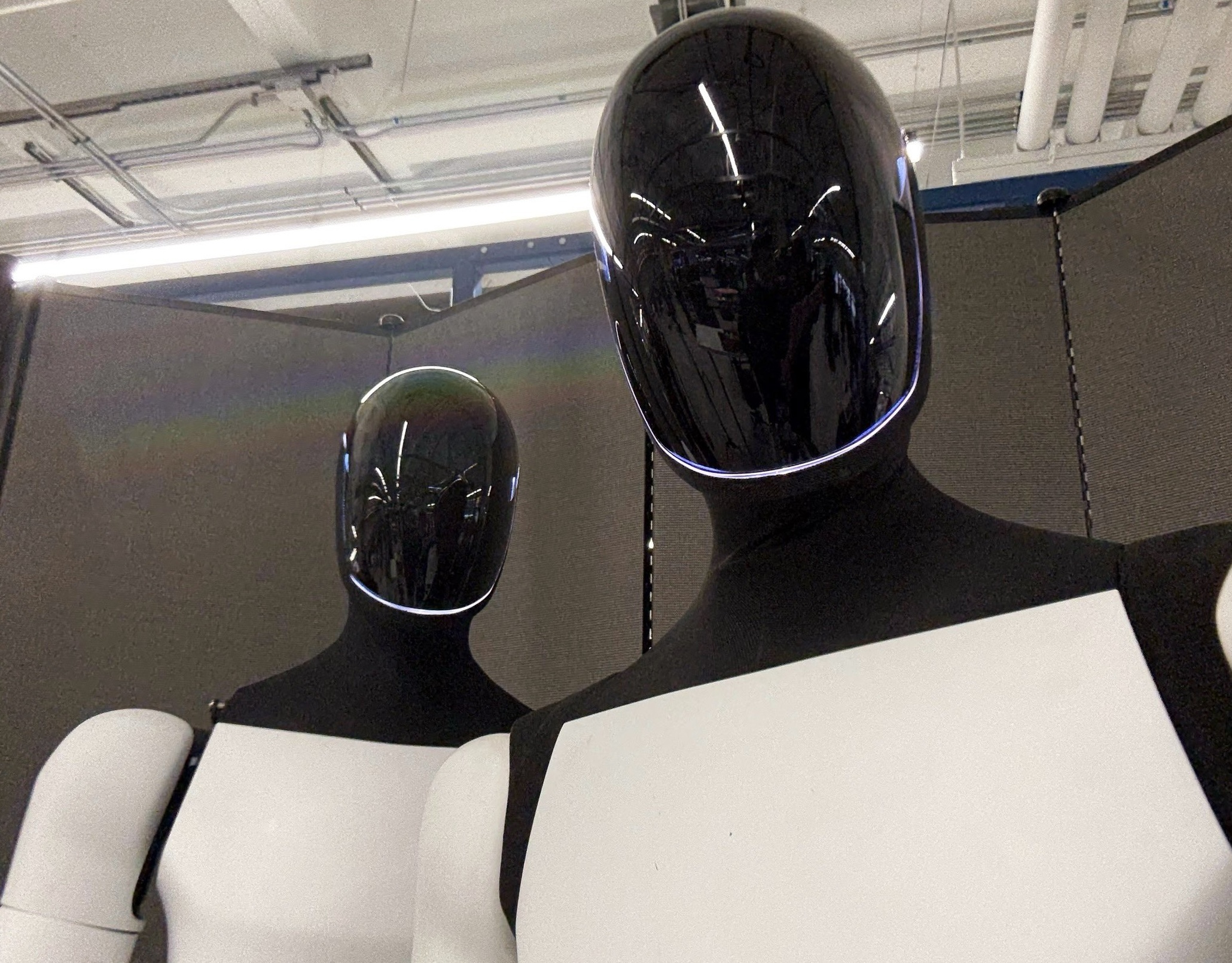
Elon Musk subtly teased Tesla’s strategy to achieve Optimus’ insane production volume targets. The CEO has shared his predictions about Optimus’ volume, and they are so ambitious that one would mistake them for science fiction.
Musk’s recent post on X, however, suggests that Tesla has a plan to attain Optimus’ production goals.
The highest volume product
Elon Musk has been pretty clear about the idea of Optimus being Tesla’s highest-volume product. During the Tesla 2025 Annual Shareholder Meeting, Musk stated that the humanoid robot will see “the fastest production ramp of any product of any large complex manufactured product ever,” starting with a one-million-per-year line at the Fremont Factory.
Following this, Musk stated that Giga Texas will receive a 10 million-per-year unit Optimus line. But even at this level, the Optimus ramp is just beginning, as the production of the humanoid robot will only accelerate from there. At some point, the CEO stated that a Mars location could even have a 100 million-unit-per-year production line, resulting in up to a billion Optimus robots being produced per year.
Self-replication is key
During the weekend, Musk posted a short message that hinted at Tesla’s Optimus strategy. “Optimus will be the Von Neumann probe,” the CEO wrote in his post. This short comment suggests that Tesla will not be relying on traditional production systems to make Optimus. The company probably won’t even hire humans to produce the humanoid robot at one point. Instead, Optimus robots could simply produce other Optimus robots, allowing them to self-replicate.
The Von Neumann is a hypothetical self-replicating spacecraft proposed by the mathematician and physicist John von Neumann in the 1940s–1950s. The hypothetical machine in the concept would be able to travel to a new star system or location, land, mine, and extract raw materials from planets, asteroids, and moons as needed, use those materials to manufacture copies of itself, and launch the new copies toward other star systems.
If Optimus could pull off this ambitious target, the humanoid robot would indeed be the highest volume product ever created. It could, as Musk predicted, really change the world.











